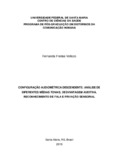| dc.creator | Vellozo, Fernanda Freitas | |
| dc.date.accessioned | 2021-05-21T12:00:36Z | |
| dc.date.available | 2021-05-21T12:00:36Z | |
| dc.date.issued | 2019-12-09 | |
| dc.identifier.uri | http://repositorio.ufsm.br/handle/1/20952 | |
| dc.description.abstract | Objective: Check the difference between tonal averages in two groups of subjects with descending audiometric configuration and analyze which one best represents the degree of hearing impairment. Furthermore, to study the Speech Recognition Percentage Index (SRPI) and its relation with the time of auditory sensory deprivation of these subjects. Method: Participated in the study 28 subjects, with descending audiometric configuration, divided into two groups: Group 1 (G1) - average frequencies of 500 Hz, 1000 Hz and 2000 Hz (TTM) equal to or less than 25 dB and Group 2 (G2) - hearing thresholds above 25 dB in TTM. The average of frequencies from: 250 Hz to 8000 Hz (8M) was compared with TTM; and with frequencies from 500 Hz to 4000 Hz (QTTM). The different tonal averages were correlated with the hearing disadvantage obtained through the HHIA/HHIE-S questionnaires. Moreover, the influence of the time of auditory sensory deprivation on the SRPI between the groups was analyzed. Results: For G1, one 8M showed a result superior to others, statistically significant, while for G2, this result was observed only in TTM. When correlating the different tonal averages with the degree of hearing impairment, the correlation strength was more expressive for 8M. The subjects in G2 had the longest time of auditory sensory deprivation and the worst scores in the SRPI. It was also observed that the longer the time of auditory sensory deprivation the worse the scores on the SRPI, being more expressive for the G2. Conclusion: For the hearing losses of descending audiometric configuration, the M8 better represented the hearing disadvantage presented by the subjects of G1. The time of auditory sensory deprivation influenced the performance of speech perception, especially when TTM was altered. | eng |
| dc.language | por | por |
| dc.publisher | Universidade Federal de Santa Maria | por |
| dc.rights | Attribution-NonCommercial-NoDerivatives 4.0 International | * |
| dc.rights.uri | http://creativecommons.org/licenses/by-nc-nd/4.0/ | * |
| dc.subject | Audição | por |
| dc.subject | Perda auditiva | por |
| dc.subject | Audiometria da fala | por |
| dc.subject | Questionários | por |
| dc.subject | Privação sensorial | por |
| dc.subject | Hearing | eng |
| dc.subject | Hearing loss | eng |
| dc.subject | Speech audiometry | eng |
| dc.subject | Questionnaires | eng |
| dc.subject | Sensory deprivation | eng |
| dc.title | Configuração audiométrica descendente: análise de diferentes médias tonais, desvantagem auditiva, reconhecimento de fala e efeito da privação sensorial | por |
| dc.title.alternative | Descending audiometric configuration: analysis of different tonal averages, hearing disadvantage, speech recognition and effect of sensory deprivation | eng |
| dc.type | Tese | por |
| dc.description.resumo | Objetivo: Verificar a diferença entre médias tonais em dois grupos de sujeitos com configuração audiométrica descendente, e analisar qual delas representa melhor o grau de desvantagem auditiva. Ainda, estudar o Índice Percentual de Reconhecimento de Fala (IPRF) e sua relação com o tempo de privação sensorial auditiva desses sujeitos. Método: Participaram 28 sujeitos, com configuração audiométrica descendente, divididos em dois grupos: Grupo 1 (G1) – média das frequências de 500 Hz, 1000 Hz e 2000 Hz (MTT) igual ou inferior a 25 dB e Grupo 2 (G2) - limiares auditivos superiores a 25 dB na MTT. Comparou-se a média das frequências de: 250 Hz a 8000 Hz (M8), com a MTT; e com as frequências de 500 Hz a 4000 Hz (MQT). Correlacionou-se as diferentes médias tonais com a desvantagem auditiva obtida por meio dos questionários HHIA/HHIE-S. Ainda, analisou-se a influência do tempo de privação sensorial auditiva no IPRF entre os grupos. Resultados: para o G1, a M8 apresentou resultado superior as demais, estatisticamente significante, já para o G2, esse resultado foi observado apenas comparado a MTT. Ao correlacionar as diferentes médias tonais com o grau de desvantagem auditiva, a força de correlação mostrou-se mais expressiva para a M8. Os sujeitos do G2 apresentaram o maior tempo de privação sensorial auditiva e os piores escores no IPRF. Observou-se, também, que quanto maior o tempo de privação sensorial auditiva piores foram os escores no IPRF, sendo mais expressiva para o G2. Conclusão: para as perdas auditivas de configuração audiométrica descendente a M8 representou melhor a desvantagem auditiva apresentada pelos sujeitos do G1. O tempo de privação sensorial auditiva influenciou no desempenho da percepção de fala, principalmente quando a MTT encontrou-se alterada. | por |
| dc.contributor.advisor1 | Garcia, Michele Vargas | |
| dc.contributor.advisor1Lattes | http://lattes.cnpq.br/8921088842000990 | por |
| dc.contributor.referee1 | Lessa, Alexandre Hundertmark | |
| dc.contributor.referee1Lattes | XXXXXXXXXXXXXXX | por |
| dc.contributor.referee2 | Vaucher, Ana Valéria de Almeida | |
| dc.contributor.referee2Lattes | XXXXXXXXXXXXXX | por |
| dc.contributor.referee3 | Salgado, Márcia Machado | |
| dc.contributor.referee3Lattes | XXXXXXXXXXXX | por |
| dc.contributor.referee4 | Costa, Maristela Julio | |
| dc.contributor.referee4Lattes | XXXXXXXXXXXXXXX | por |
| dc.creator.Lattes | http://lattes.cnpq.br/5792686681214074 | por |
| dc.publisher.country | Brasil | por |
| dc.publisher.department | Fonoaudiologia | por |
| dc.publisher.initials | UFSM | por |
| dc.publisher.program | Programa de Pós-Graduação em Distúrbios da Comunicação Humana | por |
| dc.subject.cnpq | CNPQ::CIENCIAS DA SAUDE::FONOAUDIOLOGIA | por |
| dc.publisher.unidade | Centro de Ciências da Saúde | por |



